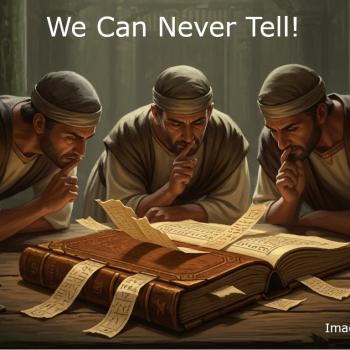Can we believe the Bible? Seeing it in context helps. When Jesus was asked about the “Greatest” or most important commandment he said it was to love God with all your being, but didn’t hesitate to add to love others as yourself. – Matthew 22:36-40. If there is a philosophy of Christian belief, this is it.

What is the Bible about?
You can get answers that differ from the four major Christian denominations, the over 200 minor denominations, and the ~45,000 worldwide denominations (people debate these numbers, defining them in different ways).
Christians can’t even agree on how many “major” denominations there are. Most say three. Count them: Coptic Orthodox Church (Egypt, Saint Mark), Eastern Orthodox Church (Eastern Europe, Apostle Paul and others), Roman Catholic Church (Western Europe, Apostle Peter and others), and Protestantism (worldwide, no apostle or saint as founder or head).
Denominations have their interpretation of scripture and individuals have their own interpretation, and some will tell you they are absolutely right and couldn’t possibly be wrong.
I will provide the following framework within which to try to understand the Bible so you can decide for yourself – not that anyone will agree on a framework.
The Bible is faith through different lenses
The Bible tells us a great deal about ancient thought about God. It explains the mystery of creation and standards (laws) for human behavior in terms ancient people could understand.
It’s not a book of science, psychology, or history. It’s a book about faith as seen through the eyes of many. Most of the Hebrew Bible with its 613 Jewish Laws in the first five books, was put into writing from around 1100 BCE to 565 BCE. This was the formative stages of Judaism covering its foundations, founders, and the prophets.
Modern standards regarding law, literature, science, psychology, sociology, history, and critical ways of thinking are relatively new to the world. The ancients simply told stories to support their founding and their beliefs.
The message of Adam and Eve
The story of Adam and Eve is an example of a view influencing the story. In the story Eve came from Adam’s rib, which removed creative power from women and gave it to men even though in reality women bring new life into the world. Had the story been subjected to literary criticism it would have fallen. Similarly by logic their children would not have found mates in the Land of Nod because Adam and Eve and their two sons were the only people. Ancient stories don’t have internal coherence (don’t make logical sense) – they’re just intended to provide a message.
Logic need not apply. The story of Adam and Eve was designed to provide a message that was pleasing to men in a patriarchal culture in which men had all the power and it would stay that way. Does this fit in the modern world?
Profound influence of the Babylonian Exile
The exile of the religious-government leaders in 565 BCE into Babylon had a profound influence on their thinking. Many felt that the exile was punishment from God for not following the Jewish Law closely enough.
This ignores that kingdoms endlessly conquering other nations was constant during this time. Capricious events are unacceptable to the human psyche, and those reasons are created to align with their faith.
The books in the Bible were thought to have been collected and selected by the religious leaders during the exile into Babylon. Books no doubt had to support the view that the exile was punishment for not following their religious Laws in their agreement with God.
This was similar to the lens seen through by those who collected the books during the era of kings. Kingship bad, old way of laws good. Therefore the kings were usually portrayed in a bad frame.
Those allowed to return to their land to rebuild the Temple carried with them a very legalistic frame of interpretation: they must be even stricter about following their religious laws. The leaders became the Sadducee Sect who governed Temple practice through the time of Jesus.
With the voices of the prophets in silence, the religion became closed to anything new. Judaism became simply an institution with the Sadducees providing two ritual Temple sacrifices per day, the Temple became an endless slaughterhouse for personal sins, with the Sadducees and other sects presiding in the Sanhedrin (court).
It was this rigid legalism and impersonal institutionalism that Jesus condemned. The “heart” of Judaism, that is love, the Great Commandments, were silenced by those who could only believe religious ritual was what God required of them.
We still have the same things going on today. The major statements in the Bible about what religion is and what God asks of us go unnoticed by many in favor of strict legalism: “This is what the Bible says!” It’s religion with its heart ripped out.
Example of Bible formulation
As the needs of the people changed, such as considering having a king, suddenly a new book made its appearance: Deuteronomy. It was “discovered,” as if pre-existing. Some of it was. The early prophets never quoted from it.
An example of the changes include: While elsewhere in the Bible sacrifices are noted throughout the land, Deuteronomy shores up the idea that sacrifice can only happen in the Temple. There could only be one Temple. This idea was strictly enforced. When the Sumerian sect constructed a Temple, the Jews destroyed it.
Scholars generally agreed that the Book of Deuteronomy was partially from other traditions, especially those in priestly circles, was concocted to meet new needs, and was conceived and written in the Seventh Century BCE, not from the much earlier date of Moses.
Deuteronomic Code. Deuteronomy. Book of Deuteronomy.
Takeaway
Stories in the Bible lack coherence (don’t make logical sense). They are told to provide a message that supports certain things.
Prophets, kings, and priests all had their lens through which they viewed faith and religion, and their slant on things is common in the Hebrew Bible. The places where the Bible disagrees with itself are at the same time testimony to it not having been methodically tampered with, and shows that it comes from different traditions.
There was a development phase of Judaism followed by an institutional phase. The institutional phase was strongly influenced by the exile and brought a very strict following of laws that to some extent lacked heart.
Religion in our time, if we don’t keep our attention on context, becomes about being an institution or about reflecting what we want as individuals.
________________________
The standard of belief and conduct for Christianity is love. Legal standard.
________________________
If you find these articles intriguing, please consider joining the mailing list.
If I’ve challenged your thinking, I’ve done my job.
___________________
Our answer is God. God’s answer is us. Together we make the world better.
– Dorian











